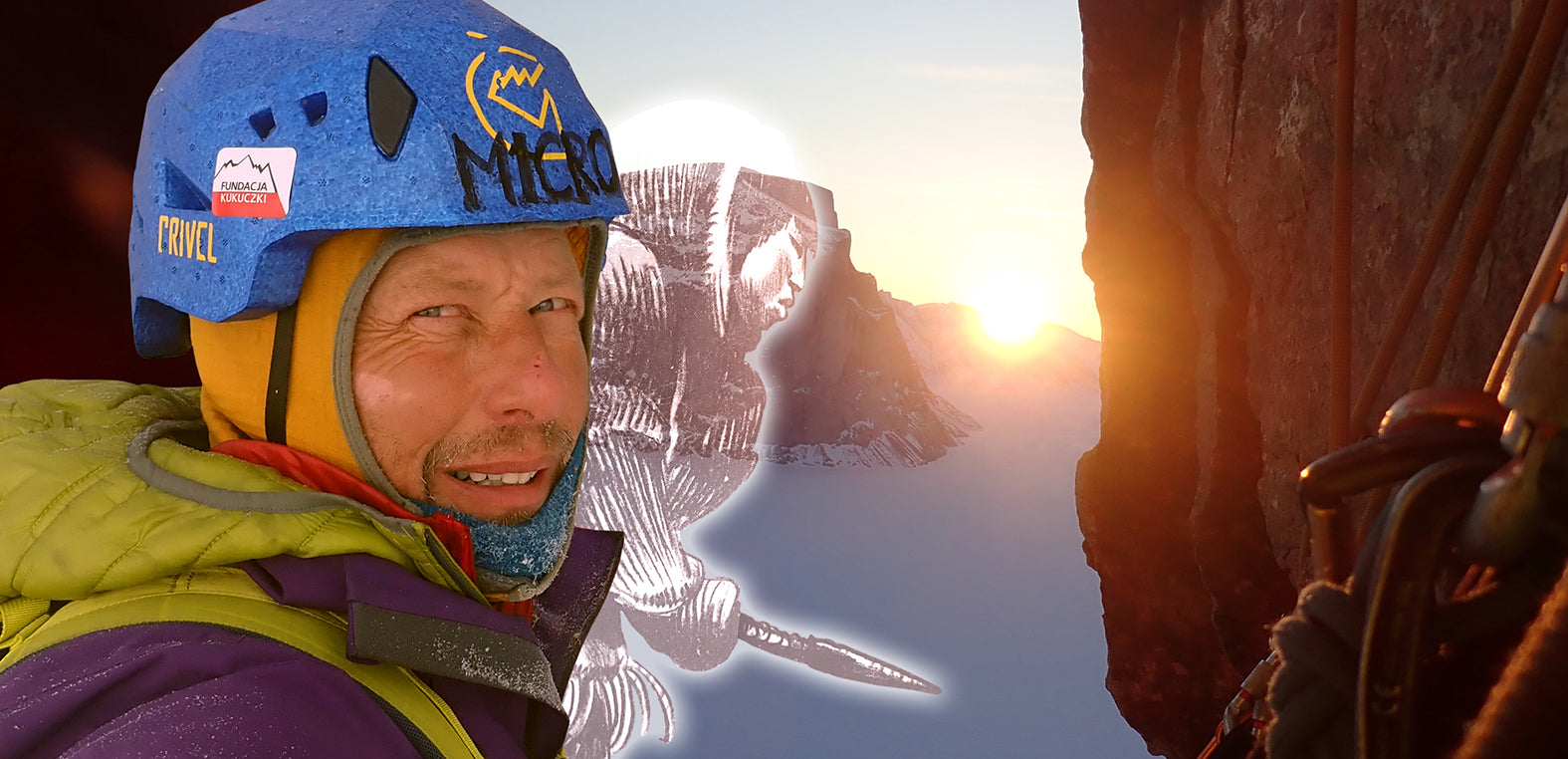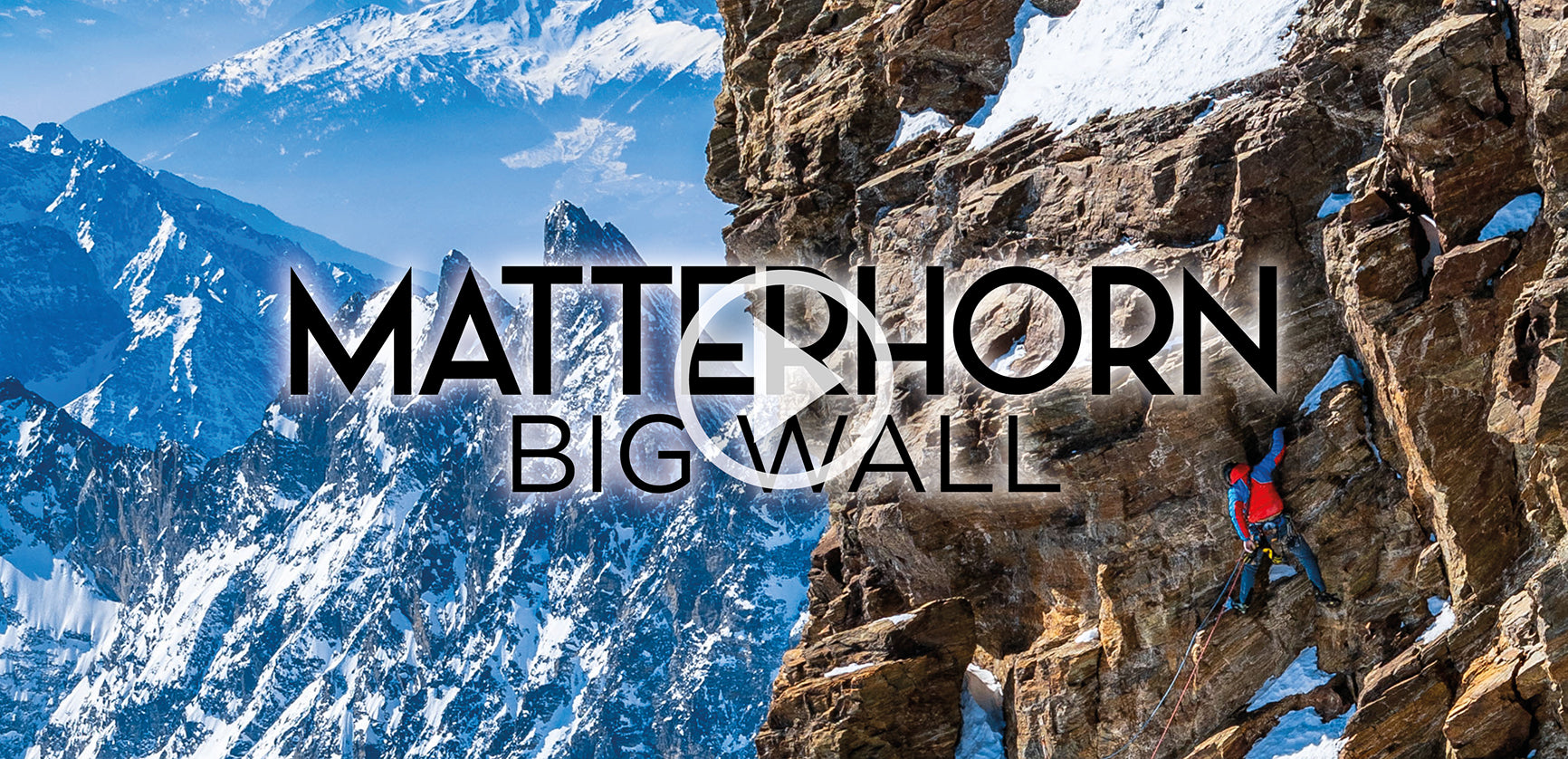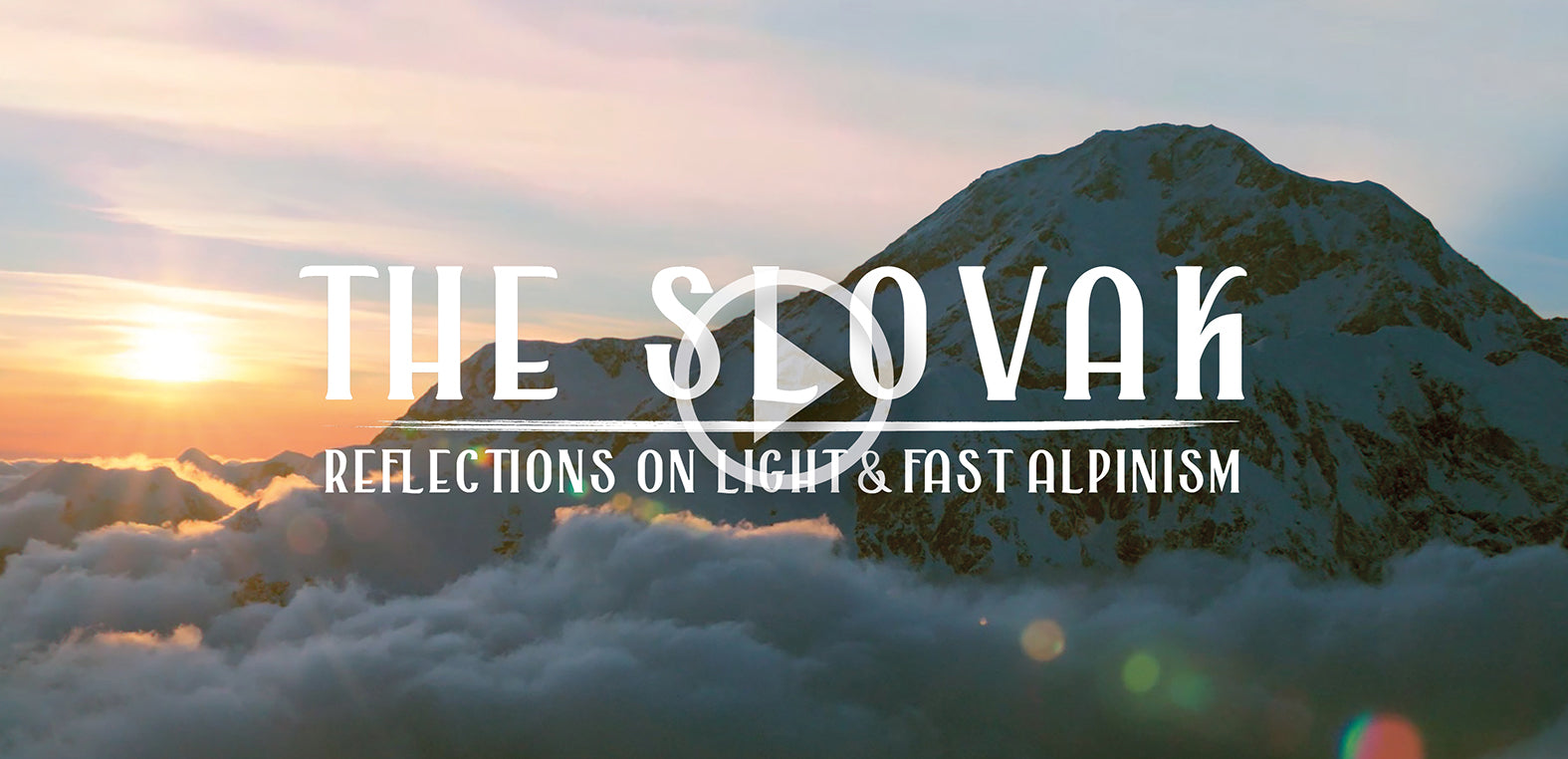
The art of surviving by Marek Raganowicz
Published on 2022/07/19
Between April 17th and May 21st, Marek Raganowicz opened MikroKozmik Variations (VII, A4 +, M5) in the Polar Sun Arm,Baffin Island (Sam Ford Fiord), Canada. The whole expedition lasted 71 days, in which Marek was alone in the Arctic environment with temperatures between -30 and -37 °C in the fjord.
Translation from Polish and editing by Luca Calvi.
On the occasion of an evening held at a high mountain club I found myself talking about expeditions to Baffin Island, or talking about the cold, the polar bears and the original inhabitants of the Arctic, but above all about wild walls and crazy climbs.

That evening, to attract my attention, it was a girl sitting in the third row who, however, had nothing special to stand out for and so I ended up wondering why it was her.
Perhaps it was precisely her silence, or perhaps that reflective air that seemed to announce the question that was finally posed to me, namely how one could survive climbing in such conditions. The presentation was coming to an end, so I briefly replied that you need to be well prepared and determined, but that you also need to be lucky in that game between the wall, the wilderness, your weaknesses and the equipment.
A couple of months later a wind storm at the base of the Troll wall blew my tent away and I was thrown back from that huge wall due to the force of the water and the snow. I went home, but only a couple of weeks later I put the equipment in my backpacks and left for Baffin Island.
It was March 20th, 2022, and the temperature in Clyde River in the Arctic region had dropped to -37 degrees Celsius. There, before leaving for the mountain, my guide Esa repeated the question to me several times:
"Do you really want me to drive you to the Sam Ford Fiord because it's even colder there?"
At that question, I kept muttering, like a stubborn ass, that I was going to the Polar Sun Spire and that nothing would hold me back. To tell the truth, I was not entirely sure that I would be able to climb that wall and resist the fury of nature in the Arctic.
Of course, I had the best equipment available, a lot of experience from previous expeditions and I felt a very strong motivation within me, but the fact remains that in that game the key role is reserved for the unknown. The question of the girl from the third row kept coming back to me, but the attraction of the challenge does not listen to what reason whispers and does nothing but push you to move forward.

So on Thursday 24th March we placed my 230 kg of luggage on the sled and after five hours of traveling by snowmobile we arrived at the foot of the wall. Accompanying me were two young Inuit, Ethan and Andy, who helped me set up the tent, lent me a traditional jacket to be able to stay warm during the walks up and down the fjord and left me a rifle with some bullets and then explained in short how to shoot polar bears, then left me with these words:
"Come on, see you in two months."
So I was left alone.

Esa had been right, it was freezing cold. Thus began the adventure, far from civilization, in the kingdom of polar bears, in the middle of nowhere, where at most you can see the sleds of hunters or wild animals passing by, where I found myself living under a wall whose end I could only see stretching my neck, to the point of having to experience unbearable pain. At first I had to get used to the reality of the Arctic, so I went for walks, to scan the wall, to observe the descent route and to check how long it takes for the batteries to recharge with the solar panel. The walks could not last more than four hours, because the cold required protection. I wore all my jackets and lastly the Inuit jacket which had a fur-lined hood, thanks to which I was able to protect my face from the cold wind and could breathe without problems.


It did not go so well with my hands and feet that froze and that I could not protect for long, thus finding myself forced to go back inside the tent to warm up with the help of the stove. On some occasions I happened to see some sleds of hunters stop, look in my direction but never get any further. They gave me the impression of wanting to keep that distance out of respect for the human need for solitude. We understood each other as it had happened the previous times and that was always the best part of all my expeditions to Baffin Island. When I realized that I was now becoming part of the Arctic world and that I was starting to live according to the natural rhythm of that environment, I decided to become familiar with the wall and began to position the fixed ropes. Every day I came out of the tent and resisted on the wall for four or even five hours, after which I had to descend, no matter if I had finished the pitch to climb or not, because the loss of sensitivity in my feet represented the insurmountable limit that I had imposed on myself.

A few days later I had already equipped 7 pitches with fixed ropes, so I rested and made the decision to finally attack the wall. From that moment on, the tent that until then had been my base camp became a dot that day by day became more and more distant in the boundless whiteness of the fjord. Inside were the jacket, the rifle with the bullets and some personal items. My home had become the portaledge and my world the north face of the Polar Sun Arm. It was time for one of those climbs that answer to the question "Who are you in reality".
The Polish writer Witold Gombrowicz once wrote “What can happen to you where nothing opposes you and nothing is able to limit you?”
Opposing me were the challenges of the Arctic, those that marked the limits of my possibilities:
The cold


On the wall I checked the temperature only a few times, but there was no sense in doing it. It was just freezing cold and I felt it even more so when I almost choked to hide my face in the double sleeping bag and when in the middle of the night I got up to turn on the stove and warm my feet, or when I got off the portaledge halfway through the pitch, terrified of the lack of sensitivity in the feet.
The snow
The snow of the Arctic on the wall is different from that of the Himalayas, the Alps or the Tatras and reminds you of the sugar with which you glaze a cake, which needs time and temperature changes to become one with what it is located below and until then it gives voice and movement to the wall, it spreads out with a single huge roaring puff as if someone had started a fire hydrant full of snow. During the 35 days on the wall I did not leave the portaledge due to the snowy dust only twice, I kept repeating to myself “Go climbing every day otherwise you will have to regret every single break”.
The breath of the wall
In March, the northern slope of the Polar Sun Spire appears to be a silent monument. Then, in April and May, it begins to breathe and express itself with the roar of falling stones. Whole blocks of rock come off, and snowy cornices fall. When I was still going to sleep in my tent, what woke me up during the night was the deafening rumble of crashes against the snow at the base of the spire, a noise that in the open wall was transformed into the hiss of the movement of air and the roars with which the boulders went to smash themselves against the rocks, from right to left, from behind….
Hunger
Before leaving Ottawa for Baffin Island, I found myself having to shop for food for all sixty days. It was Sunday March 20th, 2022, and in the morning I had a really sumptuous breakfast. A full stomach, however, ended up making me reduce the notes on the shopping list that I had prepared. It was around the time I was halfway up the face that I clearly understood that you need to go shopping when you are still hungry. During the last ten days of my route, to resist, I found myself having to cut my food ratios in half, so 5 tablespoons of crunchie, 3 candies and half a bar, since chocolate, dried meat and dried fruit were now long gone. For dinner, a real banquet with half a bag of freeze-dried food. During that time, I don't know how many times I dreamed of being in a supermarket filling my trolley with everything I was missing.
Fear

I was afraid. I know that to many people it may seem strange, because what fear can be that allows you to go to the end of the world to climb without companions a wall full of rotten rock, of unstable blocks ready to come off, of cracks that disappear, of cold and absolutely unpredictable "breaths"? Nonetheless, I was afraid, especially at the beginning, when I was not yet tired. Later I was able to get used to that wall of mine, to the life inside it and to the fear. I adapted to those "breaths", accepted the incapacities and learned to rejoice in the small victories of each day.
The tiredness
On the one hand, growing fatigue attenuates fear and feeds indifference, while on the other it causes the wall to take on a particular, personal character, perhaps because strong experiences are grafted on, rooted in memory and linked to that uniqueness of time and place. The wall stops being the precipice or the simple rock that I see before my eyes and turns into memories of winter, hunger, fear and fatigue. Memories that remain forever in our memory and that define us.
Four days after I got off the wall, while I was waiting for the plane at the Clyde River airport, I was approached by an Inuit. On his face, scorched by the icy wind, he had the white marks of his glasses, which meant to me that he was one of those hunters who whiz with snowmobiles in the white desert of the Arctic at any free moment. With his characteristic slow cadence he asked me:
“Were you the one who was climbing in the Sam Ford Fiord?
I nodded yes and gave him a polite smile.
“I went over there a couple of weeks ago, I stopped to scan the wall trying to spot you, but what I could see was only your yellow portaledge mounted above the overhangs. It's really nice to see you, you know, because then I kept wondering who that guy who had climbed that wall could possibly be and I was sure you were dead by now ...

***
MikroKozmik Variations, VII, A4 +, M5, Polar Sun Arm, Baffin Island (Sam Ford Fiord), Canada, 17.04 - 21.05.2022 (35 days) plus 7 days of fixed rope placement. First Ascent: Marek Raganowicz.
Duration of the entire expedition: 19.03- 28.05.2022 (71 days)
Days spent in the activity area (Sam Ford Fiord): 24.03 - 22.05.2022 (59 days)
Fixed rope positioning days: 7 days from 01.04 to 12.04.2022
Climbing days with bivouac on the wall: 17.04 - 21.05.2022 (35 days)
Expedition members: Marek Raganowicz, without companions, photographers or cameramen.
Communications: Text communicator (no satellite phone).
Weather conditions: In the first weeks of the expedition, the temperatures inside the fjord remained between -30 and -37 degrees Celsius. The temperatures on the open wall (north facing) were lower by 5 to 10 degrees and dropped further inside dihedrals, chimneys and cracks. For most of the bivouacs made during the ascent, the thermometer inside the portaledge showed between minus twenty and minus twenty-five. Always inside the portaledge, the maximum temperatures reached minus five during the day.
The solitary ascents of walls on Baffin Island belong to the exceptionally rare category. So far the following climbers have opened routes:
Charlie Porter (Porter Route, VI, 5.9, A4, Mount Asgard North Tower, 01-10.09.1975).
Jim Beyer (Project Mayhem, VII, 5.10c, A5c, Mt. Thor, 2 seasons 2000 i 2001).
Mike Libecki (The Hinayana, VI, 5.8, A3 +, Ship's Prow, April-June 1999).
Marek Raganowicz (two routes: 1. MantraMandala, VI, A3 +, 23.03 - 08.04.2017, Ship's Prow and 2. Secret of Silence, VI, A4, 23.04 - 01.05.2017 plus 4 days to place fixed ropes, Ship's Prow).





